全新冀教版八年级英语下册教案(全册 共155页)
- 格式:docx
- 大小:554.11 KB
- 文档页数:155
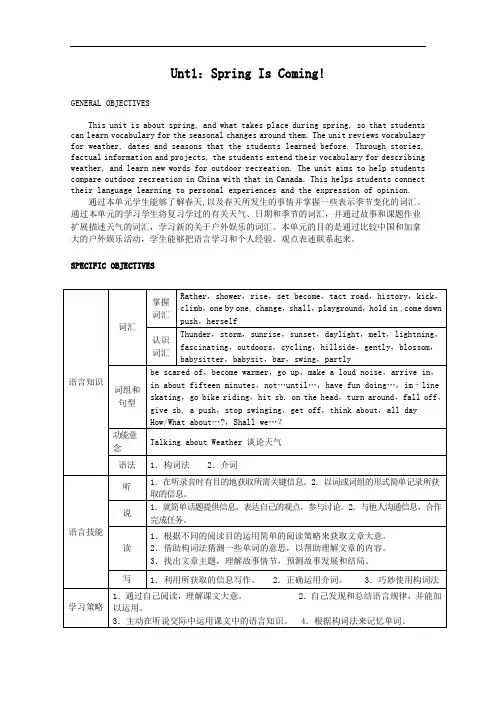
Unt1:Spring Is Coming!GENERAL OBJECTIVESThis unit is about spring, and what takes place during spring, so that students can learn vocabulary for the seasonal changes around them. The unit reviews vocabulary for weather, dates and seasons that the students learned before. Through stories, factual information and projects, the students extend their vocabulary for describing weather, and learn new words for outdoor recreation. The unit aims to help students compare outdoor recreation in China with that in Canada. This helps students connect their language learning to personal experiences and the expression of opinion.通过本单元学生能够了解春天,以及春天所发生的事情并掌握一些表示季节变化的词汇。
通过本单元的学习学生将复习学过的有关天气、日期和季节的词汇,并通过故事和课题作业扩展描述天气的词汇,学习新的关于户外娱乐的词汇。
本单元的目的是通过比较中国和加拿大的户外娱乐活动,学生能够把语言学习和个人经验、观点表述联系起来。
SPECIFIC OBJECTIVESLanguage knowledge﹡Master these words and phrases : rather, shower, rise, set﹡know these words and phrases: thunder, storm, sunrise, sunset.Class OpeningWelcome the students to come back to school. Introduce the new lesson and new students, Ask the students these questions : How is their winter holidays? Have they been anywhere? How did they spend the spring festival? what is the date today?What day is it today? What season is it? What is the weather like today? What is the temperature? Who is on duty today?Key Steps :Step 1 Ask the students to discuss the questions in “ Think About” If it is possible to show some pictures about different seasons.Step 2 . Let the students listen to the tape of the dialogue carefully with the following questions:What’s the weather like today? What’s the degree?Did Danny tell us what time the sun would rise and set?Step 3. Ask the students to read the dialogue several times in groups of three.Then ask them to act out the dialogue in groups,Step 4. Class Activity – Weather Map In this activity, Students will listen to the tape and make a weather map. Before this draw a simple map includes a city,a lake, the edge of the ocean, some mountains on the blackboard. Listen and draw.Class Closing :1) Ask the student to listen to the radio or watch TV for the next twenty-fourhours and write a weather report in English for at least eight cities.2) The next readingLesson 2 It’s Getting warmer.Language knowledge﹡Master these words and phrases : become ,fact﹡know these words and phrases: daylight , melt lightning, fascinating, go up, make a loud noiseClass OpeningAsk the student to read their weather report that they wrote according to the CCTV weather report. Then ask the same questions like yesterday.Key steps:Step1 Lead in such way : Ask How did they spend the spring festival? Was it cold during the Spring festival? Then say , “In today’s lesson, we will go on talking about the weather in spring. Can you name the four seasons in English? Ask the students to discuss and talk about the “Think About It” .Step2 Ask the students to read the text silently with the questions of exercises1 on activity books .Step3 Play the tape and ask the students to listen and read after the audiotape twice .Answer the questions to see if they can understand the text .Read the text one sentence by one sentence single. Then explain the problem they have. Pay attention to the phrases become warm , make a loud noise and so on.Step 4 Divide the students into two groups to do “ let’s do it “Step 5 Do some exercises on the activity books .Class closingread the text.The next readingLesson 3 Postcards!Language knowledge﹡Master these words and phrases : road, history, kick﹡know these words and phrases: outdoors, cycling, not…until…, have fun doing , in –line skatingClass OpeningAsk the students these questions : How is their winter holidays? Have they been anywhere? How did they spend the spring festival? what is the date today? What day is it today? What season is it? What is the weather like today? What is the temperature? Who is on duty today?Then read the text of lesson two and check the words and phrases they learned before two days.Lesson 4. Sun is rising.LESSON PREPARATl0NLANGUAGE KNOWLEDGE⊙掌握词汇及短语:climb,change,one by one⊙识别词汇及短语:hillside,gently,blossomLANGUAGE NOTES1.Weather is warming,…天气变暖和了,warm在这里是动词“变暖”的意思。
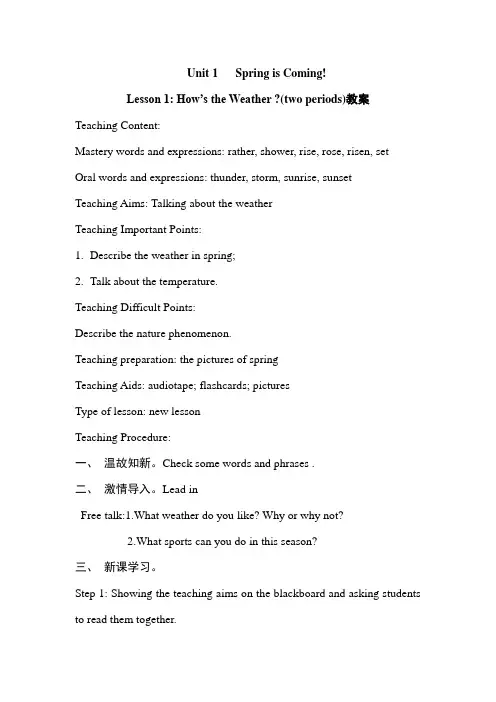
Unit 1Spring is Coming!Lesson 1: How’s the Weather ?(two periods)教案Teaching Content:Mastery words and expressions: rather, shower, rise, rose, risen, setOral words and expressions: thunder, storm, sunrise, sunsetTeaching Aims: Talking about the weatherTeaching Important Points:1.Describe the weather in spring;2.Talk about the temperature.Teaching Difficult Points:Describe the nature phenomenon.Teaching preparation: the pictures of springTeaching Aids: audiotape; flashcards; picturesType of lesson: new lessonTeaching Procedure:一、温故知新。
Check some words and phrases .二、激情导入。
Lead inFree talk:1.What weather do you like? Why or why not?2.What sports can you do in this season?三、新课学习。
Step 1: Showing the teaching aims on the blackboard and asking students to read them together.1.Remembering some new words and phrases of lesson 1 work in group.2.Talking about seasons.3.Understanding the dialogue meaning.Step2. Come to “THINK ABOUT IT”Let the students work in groups and answer the following questions:1.Look outside. Wh at’s the weather like today?2.How does this weather make you feel?Step3. Listen to the tape and answer the following questions:1.What’s the weather like today?2.It is snowing, isn’t it?3.what’s the temperature?4.Is it going to rain today, isn’t it?Step4. Read the text and check the answers. Read the text in roles.Step5. PracticeWork in three students. Suppose you are a weather reporter. Now report today’s weather to the others in your group. Then report it to the class. Step6. PracticeMake up a dialogue between two or three students in class. It is about the weather in spring. Let some students act it out before the class.四、达标训练,作业布置。
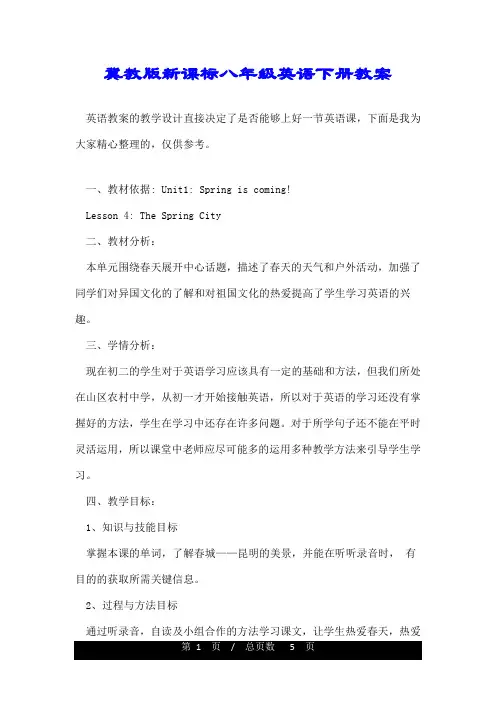
冀教版新课标八年级英语下册教案英语教案的教学设计直接决定了是否能够上好一节英语课,下面是我为大家精心整理的,仅供参考。
一、教材依据: Unit1: Spring is coming!Lesson 4: The Spring City二、教材分析:本单元围绕春天展开中心话题,描述了春天的天气和户外活动,加强了同学们对异国文化的了解和对祖国文化的热爱提高了学生学习英语的兴趣。
三、学情分析:现在初二的学生对于英语学习应该具有一定的基础和方法,但我们所处在山区农村中学,从初一才开始接触英语,所以对于英语的学习还没有掌握好的方法,学生在学习中还存在许多问题。
对于所学句子还不能在平时灵活运用,所以课堂中老师应尽可能多的运用多种教学方法来引导学生学习。
四、教学目标:1、知识与技能目标掌握本课的单词,了解春城——昆明的美景,并能在听听录音时,有目的的获取所需关键信息。
2、过程与方法目标通过听录音,自读及小组合作的方法学习课文,让学生热爱春天,热爱大自然!3、情感态度与价值观能通过谈论春天的天气,温度,空气和植物,让学生了解春天,热爱春天,了解异国文化和祖国文化的差异,拥抱大自然!五、教学重难点1、单词2、短语及语法六、教法与学法小组讨论、合作探究、教师指导七、课型新授八、教学过程Step 1.Lead-inA warming-upA sayingStep 2.pictures show and new words, then, listeningShow some pictures about spring and learn the new words by playing a game, the do the listening about the text and answer one simple question.What is the spring city?Its Kunming.Step 3.ReadingAsk several students to read the text and pay attention to the new words, the students read it again, and discuss together about the four questions in "Lets Do It.part1"Step 4. ListeningDo the listening in "Lets Do It!"part2, listen to it twice, and then invite some students to answer them.Step 5.DiscussingDivide the class into small groups; write the following words on the blackboard:Air /weather/ plants/ and outdoor activities.Step nguage points1. feel like /sound like / smell like / taste likefeel like doing sth.2. because and because ofBecause +句子Because of + n./pron./doing3. hundreds of /基数词+单位名词(hundred/thousand/million/billion)4. think of =consider5. all over the world =around the world6. all year round7. plenty of=a lot of =lots of8. long for= look forward toStep 6.Homework1、Write a short passage about spring in your hometown2、Preview Lesson 5Step 7.Summary:Review the text is very important. The students know what they will take to the class, what is useful to the study. Let them to talk about The Spring City. --- Its air, weather, plants and the outdoor activities in spring.九、板书设计:Lesson 4: The Spring CityAir weather plants and the outdoor activities十、教学反思:本节课在前几节课学习的基础上进一步来学习春天,通过运用多媒体向学生展示了春天的景色。
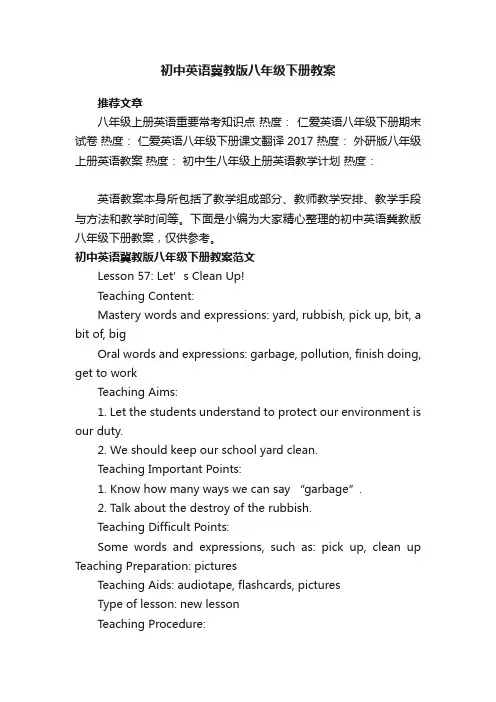
初中英语冀教版八年级下册教案推荐文章八年级上册英语重要常考知识点热度:仁爱英语八年级下册期末试卷热度:仁爱英语八年级下册课文翻译2017 热度:外研版八年级上册英语教案热度:初中生八年级上册英语教学计划热度:英语教案本身所包括了教学组成部分、教师教学安排、教学手段与方法和教学时间等。
下面是小编为大家精心整理的初中英语冀教版八年级下册教案,仅供参考。
初中英语冀教版八年级下册教案范文Lesson 57: Let’s Clean Up!Teaching Content:Mastery words and expressions: yard, rubbish, pick up, bit, a bit of, bigOral words and expressions: garbage, pollution, finish doing, get to workTeaching Aims:1. Let the students understand to protect our environment is our duty.2. We should keep our school yard clean.Teaching Important Points:1. Know how many ways we can say “garbage”.2. Talk about the destroy of the rubbish.Teaching Difficult Points:Some words and expressions, such as: pick up, clean up Teaching Preparation: picturesTeaching Aids: audiotape, flashcards, picturesType of lesson: new lessonTeaching Procedure:Step1. Come to “TALK ABOUT IT.”Step2. Show the new words to the students. Let the students read the words first. Then let them read after the tape.Step3. Listen to the tape and do Exercise 3 in activity book. Step4. Read the text and check the answers silently. At the same time, answer the following questions:1. Where are Jenny, Brian and Danny?2. How’s the weather?3. What do English people call “rubbish”?4. What is Jenny studying in class this week?5. What does the teacher think of Jenny’s idea?Step5. Read the text in roles loudly. Then let some students act it out in front of the class.Step6. PracticeExplain some language points to the class. Then ask the students to make up sentences with them.1. But look at all of the rubbish!2. Somebody should pick up that garbage!3. It would take too long.4. Each student could clean up a bit of the school yard.5. We would finish cleaning in an hour.Step7. Come to “LET’S DO IT.”Work in teams with three or four people. Let some students act their dialogue out in front of the class.Step 8. Homework1. Finish off the exercises in activity book.2. Go on the next reading in the student book.Summary:This lesson is close to our life. Try to take the students out of the classroom and show the garbage to them. Then let them saywhat they feel about the garbage. Ask them to act the dialogue out in the school yard. 冀教版英语八年级下册第八单元教案Lesson 57: Let’s Clean Up!Teaching Content:Mastery words and expressions: yard, rubbish, pick up, bit, a bit of, bigOral words and expressions: garbage, pollution, finish doing, get to workTeaching Aims:1. Let the students understand to protect our environment is our duty.2. We should keep our school yard clean.Teaching Important Points:1. Know how many ways we can say “garbage”.2. Talk about the destroy of the rubbish.Teaching Difficult Points:Some words and expressions, such as: pick up, clean up Teaching Preparation: picturesTeaching Aids: audiotape, flashcards, picturesType of lesson: new lessonTeaching Procedure:Step1. Come to “TALK ABOUT IT.”Step2. Show the new words to the students. Let the students read the words first. Then let them read after the tape.Step3. Listen to the tape and do Exercise 3 in activity book. Step4. Read the text and check the answers silently. At the same time, answer the following questions:1. Where are Jenny, Brian and Danny?2. How’s the weather?3. What do English people call “rubbish”?4. What is Jenny studying in class this week?5. What does the teacher think of Jenny’s idea?Step5. Read the text in roles loudly. Then let some students act it out in front of the class.Step6. PracticeExplain some language points to the class. Then ask the students to make up sentences with them.1. But look at all of the rubbish!2. Somebody should pick up that garbage!3. It would take too long.4. Each student could clean up a bit of the school yard.5. We would finish cleaning in an hour.Step7. Come to “LET’S DO IT.”Work in teams with three or four people. Let some students act their dialogue out in front of the class.Step 8. Homework1. Finish off the exercises in activity book.2. Go on the next reading in the student book.Summary:This lesson is close to our life. Try to take the students out of the classroom and show the garbage to them. Then let them say what they feel about the garbage. Ask them to act the dialogue out in the school yard.八年级英语复习题完型填空(10分)阅读下面短文,根据短文内容从每小题A、B、C、D中选出能填入空白处的最佳答案。

冀教版八年级下英语教案设计(新)冀教版八年级下英语教案设计会宁甘沟中学:王岚Unit 2 Lesson 13 why are plants important?【课题】: why are plants important?【教材与学生分析】本教材充分吸收了国际上新的外语教学理念和实践经验,以人物的活动为主线,围绕最基本最常用的词汇、句型逐步展开教学,有丰富多彩的练习形式和文化背景,把探究学习引入教学中使学生能主动的融入创造性有意义的整体性学习中.现在初二的学生对于英语学习应该具有一定的基础和方法,但我们所处在山区农村中学,从初一才开始接触英语,所以对于英语的学习还没有掌握好的方法,学生在学习中还存在许多问题。
就这一班学生来说已有一定的英语的基础,但还不能在英语学习中运用灵活运用,所以课堂中老师应尽可能多的运用多种教学方法来引导学生学习。
【教学目标】:语言知识:掌握本课的单词及植物植物在我们生活中的重要作用。
语言技能:在听录音时有目的的获取所需关键信息。
语言运用:能通过学习本课的对话简单的复述课文,加强对本课的阅读、理解。
情感态度:能通过谈论植物的重要性,让学生掌握植物在生活中的重要作用,并且让学生树立爱护植物的思想。
Teaching Aims:A: Learn the importance of the trees.B: Learn to how to express the usage of the trees. Learning aims:1. Remember the new words: air, energy, die, heat, nothing, bamboo, kilogram, shade, carry away, make…into.2. The important sentences:①Trees help clean the air.②Donuts don’t grow on the trees!③All plants take energy from the sun and make it into food.④Without food, they would have nothing to eat and they would die.Language Focus:1. Trees can help clean the air.help…(to) do sth. / help …with sth. 帮助…做…2. Donuts don’t grow on trees!on the tree (on trees) 与in the tree (in trees):on the tree (on trees): “在树上”,指树本身所长的东西,如树叶,花等。
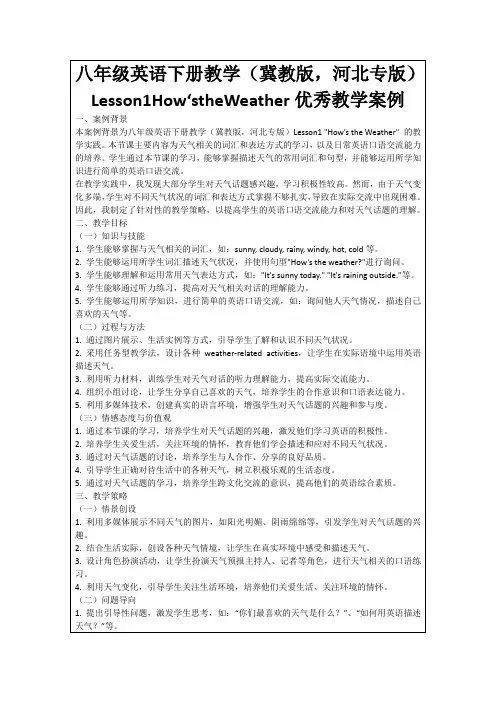

超级资源(共48套125页)冀教版八年级英语下册(全册)精品教案(word版,已编辑好)Unit 1 Spring is coming!Lesson 1 How’s the weather?本节课是冀教版初中英语八年级下册第一单元lesson1,功能话题是谈论天气;文本结构是对话;语法重点是初步认识合成词,并能够运用将来时态预测天气,以及正确使用will写简短的天气预报。
因此,在新课标理念、教材内容以及任务型教学法理论的指导下,本节课教学设计如下【知识与能力目标】The words and phrases: shower; thunderstorm; thunder; sunrise; sunset; rise; set; exact.【过程与方法目标】①What’s the weather like today?②What’s the temperature?【情感态度价值观目标】Listen, say, read and write.【教学重点】1. What’s the weather like today? It’s cold, cool, warm.2. What’s the temperature? It’s ten degrees.3. be scared of sb./sth.4. There will be…=There is/are going to be…【教学难点】1. What’s the weather like today? It’s cold, cool, warm.2. What’s the temperature? It’s ten degrees.3. be scared of sb./sth.4. There will be…=There is/are going to be…图片,PPT1.课堂导入:通过小小预报员引出“天气”话题“Do you want to be a reporter? Can you talk about the weather in English? ”给学生设置任务“用英语谈论天气”,进而引出本课的语言主题“天气”。
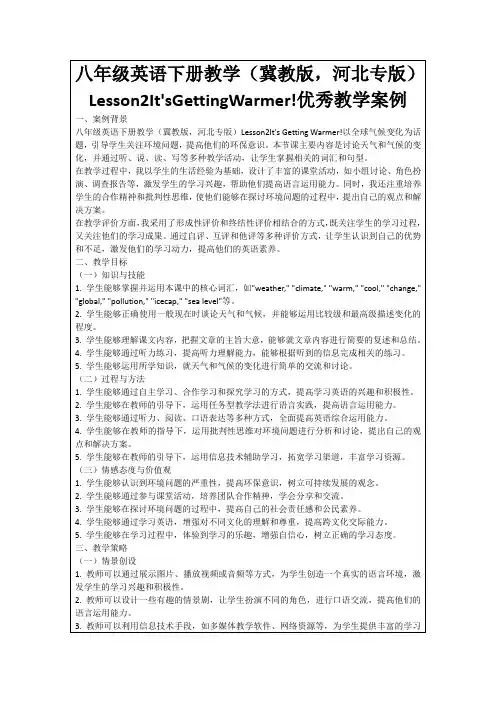
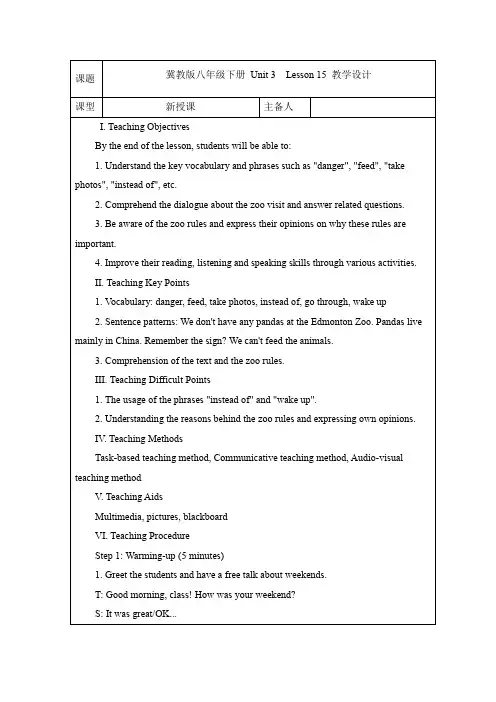
课题冀教版八年级下册Unit 3 Lesson 15 教学设计课型新授课主备人I. Teaching ObjectivesBy the end of the lesson, students will be able to:1.Understand the key vocabulary and phrases such as "danger", "feed", "take photos", "instead of", etc.prehend the dialogue about the zoo visit and answer related questions.3.Be aware of the zoo rules and express their opinions on why these rules are important.4.Improve their reading, listening and speaking skills through various activities.II. Teaching Key Points1.V ocabulary: danger, feed, take photos, instead of, go through, wake up2.Sentence patterns: We don't have any pandas at the Edmonton Zoo. Pandas live mainly in China. Remember the sign? We can't feed the animals.prehension of the text and the zoo rules.III. Teaching Difficult Points1.The usage of the phrases "instead of" and "wake up".2.Understanding the reasons behind the zoo rules and expressing own opinions.IV. Teaching MethodsTask-based teaching method, Communicative teaching method, Audio-visual teaching methodV. Teaching AidsMultimedia, pictures, blackboardVI. Teaching ProcedureStep 1: Warming-up (5 minutes)1.Greet the students and have a free talk about weekends.T: Good morning, class! How was your weekend?S: It was great/OK...T: What did you do on the weekend?S: I watched TV/played games/read books...2.Show some pictures of different animals and ask students to name them.T: Look at these pictures. What animals can you see?S: Tigers, lions, elephants...Step 2: Pre-reading (5 minutes)1.Ask students the questions in the lead-in to arouse their interest.T: What animals do you think are dangerous? Why? What rules should we obey at the zoo?S: Lions and tigers are dangerous because they are fierce. We shouldn't feed the animals and shouldn't take photos.2.Predict the content of the text based on the title and the questions.T: Today we are going to read a story about a visit to the zoo. What do you think will happen in the story?Step 3: While-reading (15 minutes)1.Fast readingAsk students to read the text quickly and answer the following questions:(1) What day is today?(2) Where do they go?(3) What time is it when they arrive?Check the answers and encourage students to express their thoughts.2.Careful readingRead the text carefully again and answer the detailed questions:(1) What do they see at the entrance?(2) What animals do they see?Discuss the answers in pairs and then share with the class.nguage pointsExplain the key vocabulary and phrases: danger, feed, take photos, instead of, go through, wake up. Provide examples and ask students to make sentences.For example:- Danger! We should stay away from the dangerous area.- Don't feed the animals. They have their own food.- We can't take photos here.- I went to school by bike instead of by bus.- The train goes through the tunnel.- Wake up, Tom! It's time to get up.Step 4: Post-reading (5 minutes)1.Group discussionDivide students into groups of four and discuss the following questions:(1) Why can't we feed the animals at the zoo?(2) Do you think the zoo is a good place for animals? Why or why not?Encourage students to express their opinions freely and have a group representative report the discussion results.2.Role-playAsk students to role-play the dialogue in pairs. One student acts as Danny, the other as Jenny or Brian.Step 5: Language practice (10 minutes)1.Do the exercises in "Let's Do It!"(1) Listen and tick the correct answers.(2) Fill in the blanks with the correct forms of the words or phrases in the box.Check the answers and explain the difficult ones.2.Writing practiceAsk students to write a story about their own trip to the zoo based on the project. Remind them to answer the questions provided.Step 6: Summary and Homework (5 minutes)1.Summarize the key points of the lesson, including the vocabulary, grammar and the zoo rules.2.Assign homework:(1) Review the vocabulary and phrases.(2) Finish the writing task and share it with the class next time.。
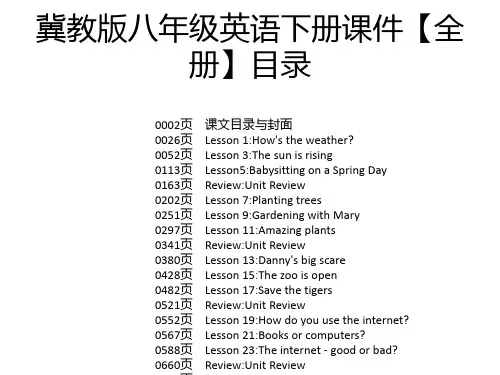
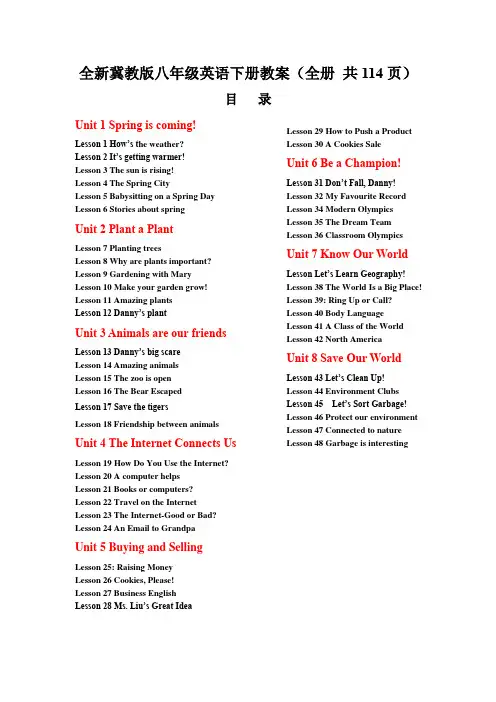
全新冀教版八年级英语下册教案(全册共114页)目录Unit 1 Spring is coming! Array Lesson 1 How’s t he weather?Lesson 2 It’s getting warmer!Lesson 3 The sun is rising!Lesson 4 The Spring CityLesson 5 Babysitting on a Spring DayLesson 6 Stories about springUnit 2 Plant a PlantLesson 7 Planting treesLesson 8 Why are plants important?Lesson 9 Gardening with MaryLesson 10 Make your garden grow!Lesson 11 Amazing plantsLesson 12 Danny’s plantUnit 3 Animals are our friendsLesson 13 Danny’s big scareLesson 14 Amazing animalsLesson 15 The zoo is openLesson 16 The Bear EscapedLesson 17 Save the tigersLesson 18 Friendship between animalsUnit 4 The Internet Connects UsLesson 19 How Do You Use the Internet?Lesson 20 A computer helpsLesson 21 Books or computers?Lesson 22 Travel on the InternetLesson 23 The Internet-Good or Bad?Lesson 24 An Email to GrandpaUnit 5 Buying and SellingLesson 25: Raising MoneyLesson 26 Cookies, Please!Lesson 27 Business EnglishLesson 28 Ms. Liu’s Great IdeaUnit 1 Spring is coming!Lesson 1 How’s the weather?◆教材分析本节课是冀教版初中英语八年级下册第一单元lesson1,功能话题是谈论天气;文本结构是对话;语法重点是初步认识合成词,并能够运用将来时态预测天气,以及正确使用will写简短的天气预报。
课题冀教版八年级下册Unit 4 Lesson 19教案课型新授课主备人一、Teaching Objectivesnguage skillsStudents will be able to understand and talk about how to use the Internet.Students will be able to master the key words and phrases related to the Internet and computer.Students will be able to use the if clause correctly.2.Knowledge objectivesStudents will learn about the different ways of using the Internet.Students will know the names of some parts of a computer.3.Emotional objectivesStudents will realize the convenience and importance of the Internet.Students will form a correct attitude towards using the Internet.二、Teaching Key Points1.V ocabulary: Internet, technology, tablet, keyboard, mouse, screen, monitor, blog, invitation2.Sentence patterns:I like to use the Internet to...If..., I will...3.Grammar: The usage of the if clause三、Teaching Difficult Points1.The understanding and application of the if clause.2.How to guide students to express their own ways of using the Internet accurately.四、Teaching MethodsTask based teaching method, Communicative teaching method, Situational teaching method五、Teaching AidsMultimedia, PPT, blackboard六、Teaching ProceduresStep 1: Warming up (5 minutes)1.Greet the students and have a free talk with them.How was your weekend?What did you do last night?2.Show some pictures of computers and the Internet on the PPT and ask the students some questions.Do you have a computer?Do you often use the Internet?Step 2: Presentation (15 minutes)1.Present the new words and phrasesShow the pictures of a keyboard, mouse, screen, monitor, tablet and explain their meanings.Write the words on the blackboard and ask the students to read them several times.2.Text learningPlay the recording of the text and ask the students to listen carefully.Ask the students to read the text silently and answer the following questions:How does Jenny use the Internet?What does Danny like to do on the Internet?Why does Brian use the Internet?Check the answers with the students and explain the key points.Step 3: Grammar Focus (10 minutes)1.Present the if clauseWrite the sentences on the blackboard:If you work hard, you'll get there in the end.If you don't stop him, he will play games the whole day.If it rains tomorrow, Danny will not go to the supermarket to buy donuts.If you go to bed now, I'll read you a bedtime story.Explain the structure and usage of the if clause:If + present simple, will + verbIf + present simple, present simpleGive some examples and ask the students to make sentences with the if clause.Step 4: Practice (5 minutes)1.Do the exercises in the textbookAsk the students to tick the things that Jenny and her classmates like to do on the Internet.Fill in the blanks with the correct forms of the given verbs.2.Group workDivide the students into groups of four. Ask each group to discuss how they use the Internet and make a list.Each group will choose a representative to present their discussion results to the class.Step 5: Consolidation (5 minutes)1.Show a search homepage on the PPT and ask the students to fill in the blanks using the category headings.A game lover can click on “Games”to play computer games.If I want to improve my spoken English, I'll go to “Language”.“Entertainment”has some excellent movies.If John wants to know more about China, he will click on “Society & Culture”.“College and University”helps Jack get information about Oxford University.2.SummarySummarize the key points of this lesson, including the new words, phrases, and the grammar the if clause.Step 6: Homework (5 minutes)1.Write a short passage about how you use the Internet.2.Finish the exercises on the workbook.七、Blackboard DesignLesson 19: How Do You Use the Internet?New words:Internet, technology, tablet, keyboard, mouse, screen, monitor, blog, invitation Sentence patterns:I like to use the Internet to...If..., I will...Grammar:If + present simple, will + verbIf + present simple, present simple。
Lesson1:What’s the Weather Like?T eaching Content:Mastery words and expressions:rather,shower,rise,rose,risen,setOral words and expressions:thunder,storm,sunrise,sunsetT eaching Aims:T alking about weatherT eaching Important Points:1.Describe the weather in spring;2.T alk about the temperature.T eaching Difficult Points:Describe the nature phenomenon.T eaching preparation:the pictures of springT eaching Aids:audiotape;flashcards;picturesT ype of lesson:new lessonT eaching Procedure:Step1.Free talk1.What weather do you like?Why or why not?2.What sports can you do in this season?e to“THINK ABOUT IT”Let the students work in gr oups and answer the following questions:1.Look outside.What’s the weather l ike today?2.How does this weather mak e you feel?Step3.Listen to the tape and answer the following questions:1.What’s the weather like today?2.It is snowing,isn’t it?3.what’s the temperature?4.is it going to rain today,isn’t it?Step4.Read the text and check the answers.Read the text in roles.Step5.PracticeWork in three students.Suppose you are a weather reporter.Now report today’s weather to the others in your group.Then report it to the class.Step6.PracticeMake up a dialogue be tw e en two or three students in class.It is about the weather in spring.Let some students act it out before the class.Step7.Homework1.Find something that represents spring and show it to the class next time.2.Finish off the activity book.Lesson2:It’s Getting Warmer!T eaching Content:Mastery words and expressions:become,became,become,factOral words and expressions:daylight,melt,lightning,fascinating1.Know something more about spring;2.The compound words.T eaching Important Points:1.When does spring begin?2.How many hours of daylight are there on March21st?3.What is the weather like?T eaching Difficult Points:the compound wordsT eaching Preparation:some pictures of springT eaching Aids:audiotape,flashcards,some picturesT ype of lesson:new lessonT eaching Procedure:Step1.Let the students on duty reports the weather to the class.The others listen and decide it is right or wrong.Step2.Listen to the tape and answer the following questions:1.What’s the date today?2.How many ways can you write dates?3.How many hours of daylight are there on March21st?4.What is spring weather like?5.What is the temperatur e of the air near lighting?Step3.Read the text and check the answers.Step4.Listen to the tape again and imitate after it until they can r ead it fluently and correctly. Step5.Ask the students to ask other questions according to the text.Y ou can begin like this:1.When does the sun rise in the morning and when does it set in the evening?2.Does it snow in early spring?3.What is sometimes with thunder and lighting?e to“LET’S DO IT”.Work in gr oup s and discuss these questions.Then let them report it to the class.Step7.Homework1.Finish off the activity book.2.Write a composition about spring.Summary:W e are enjoying spring now.W e can feel it is warmer than before.But not all of us know when the sun rises in the morning and sets in the evening.Let the students observe after class,write it down and report it to the class.It can cultivate the students’interests of learning English. Lesson3:Postcards!T eaching Content:Mastery words and expressions:r o adOral words and expressions:ou t d oors1.Grasp how to write a letter and the address.2.Know more about the spring in China and Canada.T eaching Important Points:1.Find the differences be tw e en China and Canada in spring.3.Find the differences b e tw e en the clothes that we wear in winter and in spring.T eaching Difficult Points:1.What’s the weather like in Edmonton?2.How to express one’s idea easily in a letter?T eaching Preparation:a postcardT eaching Aids:audiotape,flashcards,postcardsT ype of lesson:new lessonT eaching Procedure:Step1.Free T alkLet the students work in three and talk about the sports that we o ften do in spring.Then give a talk for the class.Step2.Have a mat chR ead the text and see who read it best.R emember to encourage the students who preview the new lesson.Step3.Listen to the tape and r ead after it.Play the tape for several times until they can r ead it fluently and correctly.Step4.Ask the students to find questions and solve them.They can ask the questions like this:1.How did Li Ming go to school on March twenty-first?2.What’s the temperature that afternoon?3.What time does the sun rise this morning?4.Is it snowing in Canada?5.When does it o ften snow in winter?6.Did Danny fall in the snow?e to“THINK ABOUT IT”Write a postcard to your friend to introduce the weather here.Then write the address and stick a stamp on it.Mail it in the post office.Step6.Homework1.Finish off the activity book.2.Listen to the song in Lesson4.Summary:Written English is an important part in English learning.Practice is the key to it.Do they have the spelling mistakes or the g rammar mistakes in the writing?Find out and help them come over it. Pay more attention to the writing because it’s an important part of communication.Lesson4:Sun Is RisingT eaching Content:Mastery words and expressions:one by one,changeOral words and expressions:hillside,gently,blossomT eaching Aim:Enjoy the beauty of the springT eaching Important Point:Grasp the changes that spring bring usT eaching Difficult Points:How to use“warm”and“gently”.T eaching Preparation:something that represents springT eaching Aids:audiotape,flashcards,pictures or flowersT ype of lesson:new lessonT eaching Procedure:Step1.Read the song aloud as a poem.This song has this song has common English words:come with me,thr ough the trees,one by one,the flowers blossom.T ranslate these expressions into English.Step2.Play the audiotape and let the students just listen with the eye closed.Step3.Play the tape again and let the students sing with it.Step4.Explain the common English expressions.Step5.Practice the song a few times,with and without the audiotape.e to“LET’S DO IT”.STEP7.Homework1.Finish off the activity book.2.Write down what you can see in spring.SummaryWe use this lesson to cultivate the students’sense of enjoying English songs.P ay attention to the rhyme,rhythm and repetition in the song.Learning English songs is a little difficult from Chinese songs.Find the ways in which we can learn fast.Lesson5:Fun in the SunT eaching Content:Mastery words and expressions:shall,kickOral words and expressions:cycling,How/What about…?Shall we…?T eaching Aims:How to enjoy oneself in spring.T eaching Important Points:1.the sports that we do in spring.2.some drills:How about…?Let’s…T eaching Difficult Points:How to advice sb.to do sth.T eaching Preparation:basketball and soccerT eaching Aids:audiotape,flashcards and ballsT ype of lesson:new lessonT eaching Procedure:Step1.Listen to the tape of Lesson4again,then let’s sing the song together.Step2.Listen to the tape and answer the following questions:1.What’s the degree?2.What will Danny wear tomorrow?3.What will they do after school?4.Why don’t Danny like basketball?Step3.Read the text and check the answers.Then read the text again.Step4.Act the dialogue out in front of the class.Step5.Make up a similar dialogue according to the text.Let’s the students act it out in front of the class.e to“PROJECT”.Divide the class into several groups.Write the answers down.Ask the several gr oups to change their answers.Step7.Homework1.Finish off the activity book.2.Review the last lesson.SummarySpring is a beautiful season.It’s the favourite season of many people.In this season,everything begins to turn green.Spring represents the beginning.W e have many things to do in it.W e can fly kites and play ball games.Running in the wind is what we like to do in our childhood.Lead your students to think har d what they like to do in this season.Let them talk freely in the class. Lesson6.Danny the babysitterT eaching Content:Mastery words and expressions:playground,hold,hold on,come down,p ushOral words and expressions:babysitter,babysit,Debbie,bar,swing,swungT eaching Aims:1.W e should love each other.2.The duty of a babysitterT eaching Important Points:1.How to demonstrate one thing clearly.3.Cultivate the spirit of loving each other.Let’s love life and peace.T eaching Difficult Points:Some verb phrases:turn around,hold on,fall off,run to,come down,climb on,give sb.a p ushT eaching Aids:audiotape,flashcards,picturesT ype of lesson:new lessonT eaching Procedure:Step1.Work in pairs.T ell your partner what you did after school yesterday.The teacher walks ar ou n d to provide help if necessary.Step2.Skim the text and ask questions by the students themselves.Then solve them by themselves, too.Let some students write their questions on the blackboard.Then let others answer them. Step3.Listen to the tape and r ead after it until they can r ead it correctly and fluently.Step4.Ask some students to come to the front and act it out.Pay attention to who is clever enough to add something new.Step5.Retell the story in a third person.e to“THINK ABOUT IT”.In a group of three,make up a“babysitting”role-play.Ask volunteers to act it out.Then it’s the other students’turn.Step7.Homework1.Finish off the activity book.2.suppose one day,you become a babysitter,what will you do?SummaryWhen we practice in the class,don’t forget to give chances to the poor students.When they have a little progress,encourage them to work hard.That’s what a good teacher should do.Lesson7:Danny’s“Debbie”DayT eaching Content:Mastery words and expressions:herselfOral words and expressions:partly,all dayT eaching Aims:1.Learn to write a diary.2.What do we write in a diary.T eaching Important Points:When we are babysitters,what can we do?T eaching Difficult Points:the P ast T enseT eaching Preparation:some toysT eaching Aids:audiotape,flashcards,some toysT ype of lesson:new lessonT eaching Procedure:Step1.Work in groups.Retell Lesson6in P ast T ense in a third person.Step2.Read the text silently by students themselves.Then answer the questions in the activity. Check the answers in the class.Step3.Listen to the tape and r ead after it.Some students may think it is easy to listen with the book.Then listen to the tape again with the book closed.At the same time,the teacher asks some students to repeat some sentences to see if they can listen clearly.Step4.Let some students read the text aloud in front of the class.Let’s have a match.Who canr ead it fast and correctly?Step5.PracticeWork in groups.Write down experience that you have ever been a babysitter.Do you think it easy to be a babysitter?Why or why not?e to“LET’S DO IT”.Step7.Homework1.Finish off the activity book.2.Do the exercises on P age9.SummaryCan you write down your experience clearly?W e o ften write in a time order.Expressing your ideas in English is not easy.So give the students more chance to practice.Writing is also an important way to check the grammars.Lesson8:Unit ReviewT eaching Content:Mastery words and expressions from Lesson1to Lesson8.Oral words and expressions from Lesson1to Lesson8.T eaching Aims:1.Know about more knowledge in spring.There are many things that we don’t know before.2.What sports do people usually do in China and in Canada?T eaching Important Points:1.What’s the weather like in spring?2.The sports that we do in spring.T eaching Difficult Points:The using of some expressions:Let’s…,shall we…?turn around,come down,finally,thenT eaching Preparation:picturesT eaching Aids:audiotape,flashcards,picturesT eaching Procedure:Step1.First let’s sing the song together.Step2.T alk with your partners about the differences be tw e en the sports that we do in China and in Canada.Step3.Have you ever been a babysitter?Let some students talk about their experience in front of the class.Step4.Finish the exercises on P age7.Find some difficulties and solve them in front of the class. Step5.Let some students talk about what we learn in this unit.What do they want to say about spring?Step6.Homework1.Finish off the exercises in activity.2.Prepare for a small quiz.SummaryThe aim of teaching is not what they learn.The most important is to teach them how to learn. Cultivate the ability of learning by themselves in the class.Encourage them to find and solve questions in class.Lesson9:How Does a Plant Grow?T eaching Content:Mastery words and expressions:plant,water,grow,leaf,cover,itselfOral words and expressions:seed,poster,bud,stem,sunshine,pot,soil,r ootT eaching Aims:1.Let the students love nature.2.Learn more about the agriculture.T eaching Important Points:1.Listen to the tape and catch the key words.2.T alk about the purpose.T eaching Difficult Points:The main plants of the plants.T eaching Preparation:pictures of plants,seeds,flowers,markersT eaching Aids:audiotape;flashcards;picturesT ype of lesson:new lessonT eaching Procedure:Step1.Bring a plant to the class.Ask the students:1.What is it?2.How does it grow?3.Have you ever planted a seed?4.How do you plant a seed?T each the students the words:seed,soil,water,plant,grow,leaf.First let some students read the words in class.Then ask all the students to read after him.Step2.Listen to the tape and answer the following questions:1.Does W an g Mei need water?2.What grows into flowers?3.What does W ang Mei use the gr een markers for?4.What does“grow into”mean?Step3.Skim the text and check the answers.Help them if they need any help.Step4.Read the text loudly in class in roles.Step5.Listen to the tape again and r epeat after it.Step6.Let some students act the dialogue out.e t o“PROJECT”.Work in three or four students in a group.Each group should finish the task.They need to plant a seed in a pot.They can plant any seed that he likes.After planting it,put it in sun.now we can observe it every day.When they are planting,the teacher walks ar ound the class.Mak e sure all the students are speaking English.If they are in trouble,help them.The teacher can ask the questions like this: What are you doing now?Have you watered your seeds?What do you cover with it?When will they sprout?Make sure that every group labels their pots with their names or group number(Example: Group1).Y ou may wish t have students also write the type of seed and the date on the label.Every group mak es a poster with pictures and words.Describe what their plants will be like. What do they do?Instruct the students to label each part of the plant in English.Have them label which parts of the plant are above ground and which parts are below.Summary:Bring a real plant to the class.P oint to the parts of the plant and ask some questions.Because this unit is about the plant,we must finish the project.Of course we can’t finish it in a class.We can do it after class and check the homework in the next class.Lesson10:Plant PartsT eaching Content:Mastery words and expressions:feed,fed,from…to…Oral words and expressions:sunlight,billion,billions ofT eaching Aims:1.Learn to describe how a plant grows.2.Learn about plant parts and what they use for.T eaching Important Points:1.Plant parts and what they are used for.2.Describe it in English.T eaching Difficult Points:Describe plant parts and what they are used for in English.T eaching Preparation:pictures,a plantT eaching Aids:audiotape,flashcards,picturesT ype of lesson:new lessonT eaching Procedure:Step1.Bring a real plant to the class.Ask the following questions:1.How many parts do plants have?2.What do roots do?3.What is the st e m for?4.What are leaves for?5.Why do plants have flowers?6.What parts do we eat?Let them answer the questions in English.If they have trouble,help them immediately.Step2.Listen to the tape and let the students complete the answers correctly.Step3.Read the text and check the answers.Step4.PracticeLet the students tak e out the pictures they bring to the class.Work with partner.T alk about the main parts of a plant and the main use of them.If they have difficulty,they can look at their book. Step5.Listen to the tape again and imitate after it until they can r ead it fluently and correctly. Step6.Let some students read the text in class.Find the mistakes and correct them.Step7.Homework1.Finish off the activity book.2.Go on the next reading in the student book.Summary:Review the text is very important.The students know what they will tak e to the class,what is useful to the study.Let them to observe the vegetables that we eat.What parts do we eat?What is it u se d for?Can they draw pictures of them?Lesson11:Look after Your Plant!T eaching Content:Mastery words and expressions:look after,over,glass,be made ofOral words and expressions:sprout,desert,use…to do…T eaching Aims:1.Learn about what a plant needs if it wants to live well.2.What does a plant use sunlight,water do?T eaching Important Points:1.Describe the process that a plant grows.3.Know the main parts of a plant and what they use water and sunlight to do.T eaching Difficult Points:Use the Simple Present T enseT eaching Preparation:a plantT eaching Aids:audiotape,flashcards,plantsT ype of lesson:new lessonT eaching Procedure:Step1.Play a game.Put some things in a box.Then let a student come to the front and touch every thing.Describe what it is like and let the students guess what it is.Divide the class into two gr oups and have a match.Which team is better?Step2.Bring a plant to the class and let the students ask questions about plants by themselves.P ointing to the plant,they may begin like this:1.What is this?2.What is it u se d for?3.Why do plants need sunlight?4.Why do plants need water?5.Why do plants need glass?Step3.Listen to the tape and check the answers.Step4.Read the text aloud in class.Find the mistakes and correct them.Step5.Listen to the tape again and r epeat after it until they can r ead it correctly and fluently. Step6.PracticeAsk the students if they have planted flowers.Let some students introduce the planting experience.Work in pairs.Introduce one plant that they love very much.Step7.Homework1.Finish off the activity book.2.Go on the next reading in the student book.Summary:Let the students tak e active p art in the activities.The teacher creates all kinds of chances to stimulate the students’e the experience that they have.Talk about what they have known.Lesson12:Pretty Little PlantT eaching Content:Mastery words and expressions:pretty,hole,itsT eaching Aims:1.T alk about the relation be tw ee n the human and the nature.2.T each people to love the plants and animals and value our lives.T eaching Important Points:1.Learn about how a plant grows.2.Realize the importance of the plants.T eaching Difficult Points:How does a plant grow?T eaching Preparation:picturesT eaching Aids:audiotape,flashcards,picturesT ype of lesson:new lessonT eaching Procedure;Step1.Draw some pictures of a plant.Let’s see how it grows.It grows from a seed.Then it gr ows buds and flowers.Step2.Read it as a poem.Then let some students explain it in English.Step3.Explain some useful words and expressions:in the hole,in the ground,all ar oundStep4.Listen to the tape and sing the song.Let’s sing after it.Step5.Play the tape for several times.Step6.Let some students sing in front of the class.Step7.Homework1.Finish off the activity book.2.Preview the next lesson.Summary:Singing is also a technique in learning English.It can increase the students’interest in English. Learning to sing can improve their listening.Find happiness in singing English songs. Lesson13Why are plants important?Learning aims:1.R emember the new words:air,energy,die,heat,nothing,bamboo,kilogram,shade,carry away, make…into.2.The important sentences:①T rees help clean the air.②Donuts don’t grow on the trees!③All plants tak e energy from the sun and mak e it into food.④Without food,they would have nothing to eat and they would die.Learning important and difficult points:1.区分短语in trees与on trees。
全新冀教版八年级英语下册教案(全册共155页)目录Unit 1 Spring is coming!Lesson 1 How’s the weather?Lesson 2 It’s getting warmer!Lesson 3 The sun is rising!Lesson 4 The Spring CityLesson 5 Babysitting on a Spring Day Lesson 6 Stories about springUnit 2 Plant a PlantLesson 7 Planting treesLesson 8 Why are plants important? Lesson 9 Gardening with MaryLesson 10 Make your garden grow! Lesson 11 Amazing plantsLesson 12 Danny’s plantUnit 3 Animals are our friends Lesson 13 Danny’s big scareLesson 14 Amazing animalsLesson 15 The zoo is openLesson 16 The Bear EscapedLesson 17 Save the tigersLesson 18 Friendship between animals Unit 4 The Internet Connects Us Lesson 19 How Do You Use the Internet? Lesson 20 A computer helpsLesson 21 Books or computers?Lesson 22 Travel on the InternetLesson 23 The Internet-Good or Bad? Lesson 24 An Email to Grandpa Unit 5 Buying and Selling Lesson 25: Raising MoneyLesson 26 Cookies, Please!Lesson 27 Business English Lesson 28 Ms. Liu’s Great Idea Lesson 29 How to Push a Product Lesson 30 A Cookies SaleUnit 6 Be a Champion! Lesson 31 Don’t Fall, Danny! Lesson 32 My Favourite Record Lesson 33 2800 Years of Sports Lesson 34 Modern Olympics Lesson 35 The Dream Team Lesson 36 Classroom Olympics Unit 7 Know Our World Lesson Let’s Learn Geography! Lesson 38 The World Is a Big Place! Lesson 39: Ring Up or Call? Lesson 40 Body LanguageLesson 41 A Class of the World Lesson 42 North AmericaUnit 8 Save Our World Lesson 43 Let’s Clean Up!Lesson 44 Environment Clubs Lesson 45 Let’s Sort Garbage! Lesson 46 Protect our environment Lesson 47 Connected to nature Lesson 48 Garbage is interesting.Unit 1 Spring is coming!Lesson 1 How’s the weather?◆教材分析本节课是冀教版初中英语八年级下册第一单元lesson1,功能话题是谈论天气;文本结构是对话;语法重点是初步认识合成词,并能够运用将来时态预测天气,以及正确使用will写简短的天气预报。
课题冀教版八年级下册Unit 1 Lesson 2: It’s Getting Warmer!说课稿课型新授课主备人一、教材分析本节课是冀教版八年级下册第一单元的第二课,单元主题是“Spring Is Coming”,主要围绕春天的天气变化、自然景象以及人们在春天的活动展开。
本节课通过一封王梅写给珍妮的信,介绍了石家庄春天的气温、花朵开放以及人们的活动等情况,同时也提到了学校即将举行的篮球比赛和班级计划的郊游。
教材内容贴近学生的生活实际,能够激发学生的学习兴趣和积极性。
通过学习本节课,学生不仅能够掌握与春天相关的词汇和表达方式,还能培养他们对自然和生活的热爱之情。
二、学情分析八年级的学生已经有了一定的英语基础,具备了一定的听说读写能力。
他们对新鲜事物充满好奇心,对与生活密切相关的话题比较感兴趣。
然而,部分学生在词汇的记忆和语法的运用上还存在一定的困难,需要教师在教学过程中加以引导和帮助。
三、教学目标(一)知识目标1.学生能够掌握单词:temperature, blossom, neither...nor..., rise, reach 等。
2.学生能够理解并运用短语:on one's way to..., the coming of..., can't wait 等。
3.学生能够掌握以下句型:- Spring has arrived in...- The temperature was...this morning. It reached...this afternoon.- I need neither...nor...now.- The days are getting longer and the sun rises earlier.(二)能力目标1.能够听懂关于春天的描述和讨论。
2.能够用英语描述春天的天气、自然景象和人们的活动。
3.能够阅读并理解与春天相关的文章。
(三)情感目标1.培养学生对大自然的热爱之情,增强环保意识。
全新冀教版八年级英语下册教案(全册共155页)目录Unit 1 Spring is coming!Lesson 1 How’s the weather?Lesson 2 It’s getting warmer!Lesson 3 The sun is rising!Lesson 4 The Spring CityLesson 5 Babysitting on a Spring Day Lesson 6 Stories about springUnit 2 Plant a PlantLesson 7 Planting treesLesson 8 Why are plants important? Lesson 9 Gardening with MaryLesson 10 Make your garden grow! Lesson 11 Amazing plantsLesson 12 Danny’s plantUnit 3 Animals are our friends Lesson 13 Danny’s big scareLesson 14 Amazing animalsLesson 15 The zoo is openLesson 16 The Bear EscapedLesson 17 Save the tigersLesson 18 Friendship between animals Unit 4 The Internet Connects Us Lesson 19 How Do You Use the Internet? Lesson 20 A computer helpsLesson 21 Books or computers?Lesson 22 Travel on the InternetLesson 23 The Internet-Good or Bad? Lesson 24 An Email to Grandpa Unit 5 Buying and Selling Lesson 25: Raising MoneyLesson 26 Cookies, Please!Lesson 27 Business English Lesson 28 Ms. Liu’s Great Idea Lesson 29 How to Push a Product Lesson 30 A Cookies SaleUnit 6 Be a Champion! Lesson 31 Don’t Fall, Danny! Lesson 32 My Favourite Record Lesson 33 2800 Years of Sports Lesson 34 Modern Olympics Lesson 35 The Dream Team Lesson 36 Classroom Olympics Unit 7 Know Our World Lesson Let’s Learn Geography! Lesson 38 The World Is a Big Place! Lesson 39: Ring Up or Call? Lesson 40 Body LanguageLesson 41 A Class of the World Lesson 42 North AmericaUnit 8 Save Our World Lesson 43 Let’s Clean Up!Lesson 44 Environment Clubs Lesson 45 Let’s Sort Garbage! Lesson 46 Protect our environment Lesson 47 Connected to nature Lesson 48 Garbage is interesting.Unit 1 Spring is coming!Lesson 1 How’s the weather?◆教材分析本节课是冀教版初中英语八年级下册第一单元lesson1,功能话题是谈论天气;文本结构是对话;语法重点是初步认识合成词,并能够运用将来时态预测天气,以及正确使用will写简短的天气预报。
因此,在新课标理念、教材内容以及任务型教学法理论的指导下,本节课教学设计如下◆教学目标【知识与能力目标】The words and phrases: shower; thunderstorm; thunder; sunrise; sunset; rise; set; exact.【过程与方法目标】①What’s the weather like today?①What’s the temperature?【情感态度价值观目标】Listen, say, read and write.◆教学重难点【教学重点】1. What’s the weather like today? It’s cold, cool, warm.2. What’s the temperature? It’s ten degrees.3. be scared of sb./sth.4. There will be…=There is/are going to be…【教学难点】1. What’s the weather like today? It’s cold, cool, warm.2. What’s the temperature? It’s ten degrees.3. be scared of sb./sth.4. There will be…=There is/are going to be…◆课前准备图片,PPT◆教学过程1.课堂导入:通过小小预报员引出“天气”话题“Do you want to be a reporter?Can you talk about the weather in English?”给学生设置任务“用英语谈论天气”,进而引出本课的语言主题“天气”。
2.学习新知(1)复习snow,wind,rain,cloud,sun首先利用网站中“单词袋袋裤”中的“温故”栏目出示天气图片,学生看图片猜单词,从而复习snow,wind,sun,cloud,rain这几个单词,同时板书单词。
【设计意图:学生复习snow,wind,rain,cloud,sun几个名词,引出cloudy,rainy,snowy,sunny,windy的学习,并为对比名词和形容词做准备。
】整合点:运用网站展示图片使教学内容更直观、更形象,从而帮助学生更好的掌握有关天气的单词。
(2)学习新知snowy,windy,rainy,cloudy,sunnyT:Please look out of the window.The sun comes out.The weather is sunny.It’s warm.板书sunny,和sun对比。
学生小组讨论在snow,wind,rain,cloud的后面做怎样的变化形成本课所要学习的形容词。
此时充分调动学生的学习主动性,小组派代表汇报结果,同时板书单词,之后通过网站中“单词袋袋裤”的“知新”栏目查找这些单词的汉意,教师指导学生进行单词的朗读。
【设计意图:学生通过比较,初步了解本课中的天气词汇与上一课学习的名词的联系。
】(3)通过网站自学第一部分点击网站的“看图识天气”栏目播放课文第一部分的flash课件,学生结合具体情境进行一对一的跟读模仿。
【设计意图:通过一对一的跟读模仿,培养学生自主学习的能力。
】整合点:通过网站播放学习内容,将静态的文字转化成动态的情境,刺激学生的多种感官,有利于学生更好的模仿和实践。
(4)填一填通过“填一填”栏目,复习本课形容天气的词汇,学生输入答案,回答正确与否会有相应的提示音。
【设计意图:通过操练,培养学生正确运用天气词汇。
】(5)学习句型How’s the weather today?It’s_______.学生先整体感知,自主学习网站上的视频对话,进行一点一说的学习,跟读对话。
然后结合实际情况教师提问:“How’s the weather today?”“How’s the weather in(月份)?”师生对话、生生对话,充分练习此句型。
【设计意图:学生学会使用How’s the weather today?It’s______.句式问答天气。
】整合点:学生通过网站的视频资源自主学习,充分发挥了学生的自主能动性。
3.巩固操练(1)点击“智力大冲浪”栏目,出现相应的日期和天气情况,生生操练句型“What day is it?”“How’s the weather today?”(2)然后点击网站中的“天气转转转”栏目,转出相应的城市天气,师生对话、生生对话,讨论此城市的天气状况。
【设计意图:在轻松愉快的气氛中,学生巩固运用本课描述天气的词汇和句型,做到学以致用,语言输出。
】整合点:利用网站,学生自己亲自操作电脑,师生对话和生生对话,使英语课堂变得丰富多彩,增加趣味性。
(3)找规律,学习字母组合ir,ur,er,or在单词中的发音将这些不同字母组合的单词打乱顺序,学生将这些单词分类,然后指导学生读一读,找到规律后,尝试读新的单词。
【设计意图:通过找规律、总结,学生掌握字母组合在单词中的发音。
】整合点:学生在电脑上通过拖动完成单词分类,实现了人机互动,激发了学生的学习兴趣和参与热情。
4.自我展示这节课我们学习了五个描述天气的形容词,但是在实际的生活中,天气情况远不止这些,学生通过网站拓展栏目查找foggy等更多描述天气的词汇,然后通过中国天气网,观察图片,选择某一城市结合之前学过的句型What day is it?What do you wear?及本课新句型创编对话。
5.结束课堂Homework:选一个季节,和同学或父母谈论这个季节的天气情况。
Unit 1 Spring is coming!Lesson 2 It’s getting warmer!◆教材分析Talking about weather and spring..Talking about outdoor activities.◆教学目标【知识与能力目标】The new words and language points: neither; nor; boot; jasmine; blossom; sunshine; swing 【过程与方法目标】Spring has arrived in Shijiazhuang.I see many people in the park exercising.【情感态度价值观目标】Listen, say, read and write.◆教学重难点【教学重点】1) 区分arrive 与reach2) neither… nor…e.g. I need neither my heavy winter coat nor my boots now!Ask and describe the weather of spring.1. What is spring weather like?2. It becomes warmer. The temperature goes up!【教学难点】1) 区分arrive 与reach2) neither… nor…e.g. I need neither my heavy winter coat nor my boots now!Ask and describe the weather of spring.1. What is spring weather like?2. It becomes warmer. The temperature goes up!◆课前准备图片,PPT◆教学过程【预习案】(10分钟)1、大声朗读课文,理解课文大意,在文中划出生词和下列句子并背诵。